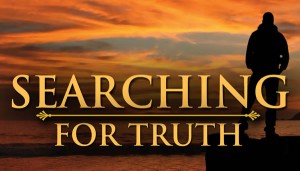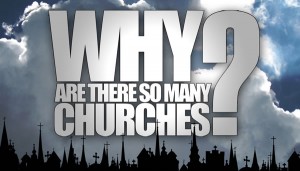The biblical balance between faith and reason is further explained by the close relationship between the Creator and his creation, between nature and super-nature. Psalm 19 provides a prime case in point. Verse one reads, “The heavens declare the glory of God, and the sky above proclaims his handiwork” (19:1 ESV). But it is not the sky alone that speaks: day and night pour out speech and reveal knowledge (19:2-3), and “Their voice goes out through all the earth, and their words to the end of the world” (19:4). Even the natural revolution of the earth around the sun declares the awesome fact that there is a Creator (19:4-6).
That being said, the Psalm also teaches us that God’s self-revelation through nature can only say so much on its own. But since Yahweh has also revealed himself through his word (law, testimony, precepts, fear and judgments) and it is worthy of our trust (perfect, sure, right, pure, clean and true), we can also know and experience him personally as our Redeemer (revival, wisdom, joy, enlightenment, eternal life, righteousness, pleasure, reward, forgiveness, integrity, innocence and favor), which itself points back to his work in creation (soul, heart, eyes, gold and honey; 19:7-14). We can therefore sing with Asaph, that “The heavens declare his righteousness, for God himself is judge” (Psa 50:6)!
For this reason, statements of God’s creative work occur often and naturally throughout both Scripture and nature. Thus, as Paul writes to Corinth, “For although there may be so-called gods in heaven or on earth . . . yet for us there is one God, the Father, from whom are all things and for whom we exist, and one Lord, Jesus Christ, through whom are all things and through whom we exist” (1Co 8:5-6). So while it is by faith that we as believers “understand . . . the universe was created by the word of God” (Heb 11:3), it is also a fact accessible to all mankind. As Athanasius once wrote, God has created humanity in such a way that “by looking into the heights of heaven, and perceiving the harmony of creation, they might know its ruler, the Word of the Father, who, by his own providence over all things, makes the Father known to all” (De incarnatione 12, quoted in McGrath, ch. 7; see John 1:1, 18).
God’s creativity, though, is not confined to the beginning; his supernatural conservation of the cosmos continues alongside and empowers natural processes. “For by him all things were created, in heaven and on earth, visible and invisible, whether thrones or dominions or rulers or authorities—all things were created through him and for him. And he is before all things, and in him all things hold together” (Col 1:16-17). So just as “the universe was created by the word of God” (Heb 11:3), the Son “upholds the universe by the word of his power” (1:3), and “by the same word the heavens and earth that now exist are stored up for fire” (2Pe 3:7). All creation is therefore radically dependent on the Voice who spoke in Genesis 1, became flesh in John 1, and that John turned to see in Revelation 1.
As Calvin would point out to the Einsteins of today, “to make God a momentary Creator, who once for all finished his work, would be cold and barren, and we must differ from profane men especially in that we see the presence of divine power shining as much in the continuing state of the universe as in its inception” (Institutes 1.16). And though Calvin took God’s creativity and omnipotence further than the Bible teaches, he is correct in seeing creation as the continuous out-working of God’s creativity. After all, it was Jesus who told the Jewish leaders, “My Father is working until now, and I am working” (John 5:17). As Tillich stated, “The doctrine of creation is not the story of an event which took place ‘once upon a time.’ It is the basic description of the relation between God and the world” (141-142). Because of this, we should think of God’s creation as active through every phase of time—past, present and future—his originating creativity, sustaining creativity, and directing creativity.
For example, note the use of the present tense in Psalm 104: God himself stretches out the heavens, establishes the earth and seas, waters and feeds his creatures, causes vegetation to grow, and creates both darkness and light. And yet each of these is also an ongoing natural process governed by natural laws accessible to scientific inquiry: thermodynamics, gravity, strong and weak nuclear forces, the water cycle, photosynthesis, and the conservation of mass and energy. The Psalmist therefore attributes both causes—natural and supernatural—to the Lord: “When you send forth your Spirit, they are created, and you renew the face of the ground” (Psa 104:30).
David sees these same forces at work in the special creation of each individual human being: “For you formed my inward parts; you knitted me together in my mother’s womb. I praise you, for I am fearfully and wonderfully made. Wonderful are your works; my soul knows it very well” (Psa 139:13-14). And though we understand much about the biological processes God uses to build our “frame . . . intricately woven in the depths of the earth,” it is still ultimately a “secret” of his sustaining and directing creativity manifested in his providential rule through nature: “Your eyes saw my unformed substance; in your book were written every one of them, the days that were formed for me, when as yet there was none of them” (139:15-16).
Thus, even the regular operation of natural processes is a testament to the divine. Jeremiah could therefore speak of the Lord’s “covenant with day and night and the fixed order of heaven and earth” (Jer 33:25). And as Paul told the people of Lystra, God “did not leave himself without witness, for he did good by giving you rains from heaven and fruitful seasons, satisfying your hearts with food and gladness” (Acts 14:17). Augustine therefore comments, “For, quite apart from the prophets, the very order, changes, and movements in the universe, the very beauty of form, in all that is visible, proclaim, however silently, both that the world was created and also that its Creator could be none other than God whose greatness and beauty are both ineffable and invisible” (The City of God 11).
So if God created the world and its natural processes, and even these natural processes are radically dependent upon a radically independent God, nature and super-nature are in perfect harmony. For this reason, “The ‘naturalness’ of natural events does not consist in being somehow outside God’s providence. It consists in their being interlocked with one another inside a common space-time in accordance with the fixed pattern of the ‘laws’” (Lewis, Miracles 284; see 291). Therefore, “All existential conditions are included in God’s directing creativity. They are not increased or decreased in their power, nor are they cancelled. Providence is not interference; it is creation. It uses all factors . . . in creatively directing everything toward its fulfillment” (Tillich 146). Paul agrees, and his words are rightfully more familiar to Christians today, “all things work together for good, for those who are called according to his purpose” (Rom 8:28). Nature and super-nature are therefore in perfect harmony because both begin and end in God himself.
Perhaps most surprising to some, is that this same recognition of consistent natural laws and their self-evident design serves as the first condition for modern science. Methodological naturalism only works because the natural world has an in-built ordering principle allowing it to be interpreted through human reason. Simply put, nature does not lie, because God is the one who speaks through nature. In fact, as Lewis writes, “Men became scientific because they expected Law in Nature, and they expected Law in Nature because they believed in a Legislator” (Miracles 169).
Natural laws therefore point to design, and a Designer who works out his providential plan through nature (creation) and history (redemption). As Oden points out, “It is the one God who creates the world, permits its freedom to fall, acts to redeem what has fallen, and brings the whole story to fitting consummation” (1.1.6). Nature and super-nature are therefore in perfect harmony, because God’s own creativity and providence are the means by which he unites all things in him. For, “When all things are subjected to [God], then the Son himself will also be subjected to [God] who put all things in subjection under him, that God may be all in all” (1Co 15:28).
Works Cited
- Augustine. The City of God. Readings in Christian Theology. Ed. Peter C. Hodgson & Robert H. King. Philadelphia: Fortress, 1988. 118-123.
- Calvin, John. Institutes of the Christian Religion. Readings in Christian Theology. Ed. Peter C. Hodgson & Robert H. King. Philadelphia: Fortress, 1988. 123-128.
- The ESV Study Bible. Ed. Lane T. Dennis & Wayne Grudem. Wheaton: Crossway, 2008. Bible Study with Accordance.
- Lewis, C.S. Miracles. New York: HarperCollins, 1947. Print.
- McGrath, Alister E. Surprised by Meaning: Science, Faith, and How We Make Sense of Things. Louisville, KY: Westminster John Knox, 2011. iBooks.
- Oden, Thomas C. Classic Christianity. HarperCollins, 2009. iBooks.
- Tillich, Paul. Systematic Theology. Vol. 1. Readings in Christian Theology. Ed. Peter C. Hodgson & Robert H. King. Philadelphia: Fortress, 1988. 141-146.
Cross-posted from In His Image.





